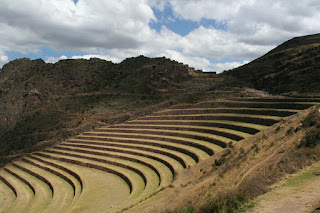 |
| Sacred Valley |
We first paid a visit to the Ccaccaccollo women's weaving community - a small village that saw little tourism and diminishing returns on their agriculture until the Planeterra foundation stepped in to support them.
 |
| Ladies spinning |
While the men work in Cusco or as porters on the Inca trail, the women of the community fashion textiles for sale to tourists. The process is intensive, with every step done by hand from the shearing of the llamas to the washing, spinning, dyeing, and weaving of the wool.
 |
| Weaving |
 |
| Dyeing |
 |
| Little helper |
A lady demonstrated how a certain plant root foams in water and can be used as a natural soap to clean the wool. Ladies stood around with wooden spinning tops in hand, teasing the soft fibres into a single thread. Dyeing also used plants to achieve a range of natural colours, but the cochineal beetle - a parasite found on a type of cactus - produces a wide spectrum from yellows, through orange and red to purples.
 |
| Hecho a mano |
The yarn is boiled over dried llama poo with the dye and fixed using a small amount of urine (the urea makes sure the colour stays). Finally, the creation of hats, ponchos, scarves, shawls, gloves and more is achieved both by hand and using looms.
Our next stop was the Inca ruins of the town of Pisaq - named after the partridge. This town grew up owing to its convenient location to stop on the route to Cusco. Houses were established for those staying in the area and soon agriculture was started to feed the people using the terraced approach to combat the lack of flat land.
 |
| Pisaq terraces |
Lunch came courtesy of another Planeterra project, which has brought custom to a small town on the Urubamba river. The community-run Parwa Restaurant is located in a beautiful setting and serves well cooked and presented Peruvian food.
We started with a salad and causa - yellow potato filled with avocado - followed by soup.
 |
| Causita |
Three kinds of quinoa was served alongside a stuffed rocoto pepper in a batter. We finished in true Peruvian style with mazamorra morada and a morsel of passion fruit cheesecake.
 |
| Stiffed rocoto pepper |
Our route continued along the path of the Urubamba river through the valley and the town of the same name. At the far end we found the town of Ollantaytambo.
 |
| Brooding Ollantaytambo |
The town is named after Ollanta, a warrior who wanted to marry the daughter of the King (Pachacútec), but was refused. The site is like an abandoned building site, whose part-finished construction helps to demystify some of the Inca building techniques. We could see that the large, impossibly heavy stones were rolled over gravel using protruding 'handles' on the rock to attach ropes (sometimes as far as 8km). Ramps of soil and wooden levers were used to hoist the stones into position. Given the hardness of the granite rock (hardness 6 on the Mohs scale), iron meteorite (hardness 8) was used to chisel and fashion them into the precisely interlocking shapes. When no natural faults could be used to divide stones into smaller pieces, "hanging the rock" was used to chop it in half, taking advantage of gravity.
Ollantaytambo is also the start of the Machu Picchu trail and, as such, offers accommodation and dining options to hikers before and after their trip. We checked into Ollantaytambo Lodge at the 'quiet' end of town, although to be honest, the whole place is quite sleepy as most people here are leaving early in the morning.
With our group of hikers, we took dinner at The Station. Although we should probably be taking on sufficient calories for tomorrow's hike, the large lunch left us with only appetite for quinoa soup and a stuffed avocado, respectively. The meal was probably the best we could we could hope for in a town which seemed to think that 'vegetarian food' comprises barely defrosted vegetable mix.
 |
| Nice try |
No comments:
Post a Comment